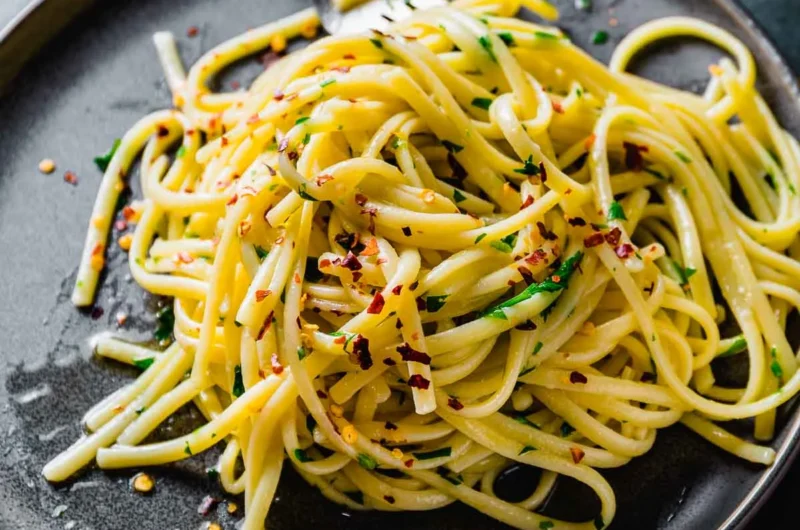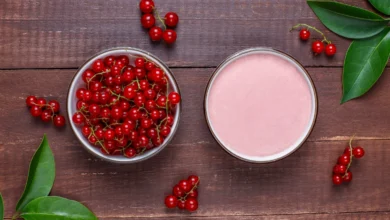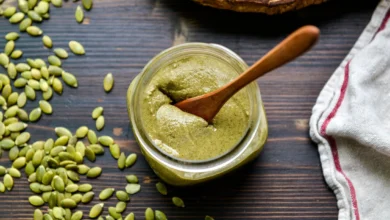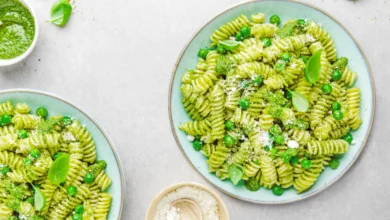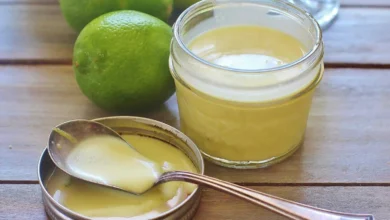
Feeling that mid-week, hump-day slump? Those long days stretching towards the weekend can leave anyone’s mood flat and motivation for cooking at an all-time low. That’s where the Queen of simple pasta dishes reigns supreme: Linguine Aglio e Olio. With only a few ingredients – garlic, oil, a sprinkle of chili flakes if you like a kick, and of course some perfectly cooked linguine – you can whip up a flavorful meal faster than you can say “I’m too tired to cook tonight.”
Contents
- Aglio e Olio Linguine
- Aglio e Olio Linguine Recipe
Aglio e Olio Linguine
Some culinary masterpieces demand hours of attention. Aglio e Olio (pronounced “ah-lee-oh eh oh-lee-oh”) shines for the opposite reason. It’s a dish I remember from my childhood. Maybe it was my mom, maybe my Italian grandma, showing me that food could be both delicious and easy, even back then. Don’t be fooled by its simplicity, though. Think of it less like “just garlic and oil” and more like the culinary equivalent of a favorite pair of jeans; reliable, comfortable, and always gets the job done.
A Few Important Tips:
While spaghetti aglio e olio is beautifully simple, here are some tips to ensure perfection:
- Prep Your Ingredients: For the best flavor, have everything laid out and chopped before you start cooking. Your pasta cooks quickly, and you don’t want to rush.
- Watch That Garlic: This is the most important tip! Garlic burns easily, and once it turns bitter, there’s no going back. As soon as it’s lightly golden, remove the pan from the heat for a moment if needed. Your pasta will finish cooking in no time, and you can add it back then.
- Don’t Forget the Salt: You’ve heard it before, but it’s the main way to truly season your food. A generous helping of sea salt in the pasta water makes all the difference.
What Type of Oil for Aglio e Olio?
With a recipe this minimal, each ingredient counts. It’s especially important to use the best quality oil available. For aglio e olio, that means extra virgin olive oil. It brings a rich, fruity flavor that’s a core part of this dish. If extra virgin isn’t in your budget, regular olive oil can work for sautéing, but finish the prepared dish with a drizzle of the good stuff – the flavor difference is significant.
Many YouTube chefs and online recipes advise against ever using extra virgin olive oil for cooking, citing its lower smoke point. However, aglio e olio is all about gentle cooking over medium heat. The oil brings an irreplaceable flavor component to this simple, beautiful dish.
Nutritional Information
| Nutrient | Amount |
| Calories | 549kcal |
| Carbohydrates | 63.6g |
| Protein | 13.1g |
| Fat | 27.8g |
| Saturated Fat | 4g |
| Cholesterol | 83 mg |
| Sodium | 300 mg |
| Potassium | 221 mg |
| Fiber | 0.1g |
| Sugar | 0.1g |
| Calcium | 25 mg |
| Iron | 4 mg |
Aglio e Olio Linguine Recipe
Course: MealsCuisine: Italian2-4
servings5
minutes15
minutes500
kcal20
minutesWhile this classic Italian dish is all about keeping things brief, a little attention to your ingredients makes all the difference. Here’s the breakdown:
Ingredients
The Pasta Noodle: Spaghetti Aglio e Olio is traditionally made with spaghetti. Feel free to use linguine or any long pasta you prefer.
Olive Oil – The Main Ingredient: Since it’s such a star, use the best-quality extra virgin olive oil you can find. That rich, fruity flavor is worth the investment.
Garlic, Garlic, and More Garlic: Aglio means “garlic” in Italian, so get closer to tons than a few cloves. Traditionally the garlic is thinly sliced, not minced.
Crushed Red Pepper Flakes (Or Not): A touch of heat is traditional, but fresh peperoncini (red hot chile peppers) are how it’s done in Italy. If you can only find dried, that’s perfectly fine! Simmer them gently in the oil to release more flavor.
Optional Garnishes / Popular Toppings: A sprinkle of minced fresh parsley adds vibrancy, and freshly grated Parmesan brings a salty richness to this classic Italian dish. Both are optional, but delicious!
Directions
- Cook the Pasta: Bring a large pot of generously-salted water to a rolling boil. Add your pasta and cook until al dente (slightly firm to the bite).
- Sauté the Garlic: Meanwhile, as your pasta works its magic, heat the olive oil in a large sauté pan over medium heat. Add the sliced garlic and crushed red pepper flakes (if using) and sauté until the garlic is lightly golden. Be careful not to burn it!
- Toss in the Sauce: When the pasta is ready, use tongs to transfer it immediately to the sauté pan along with a splash of the starchy pasta water. Toss continuously until the pasta is evenly coated. Give it a taste and season with a pinch of salt as needed.
- Serve it Hot: Plate your pasta immediately and serve it hot, garnished with your favorite toppings. Enjoy! This dish is all about that garlicky, savory flavor and the simple joy of perfectly cooked pasta. Buon appetito!
Notes
- Use the best quality extra virgin olive oil you can find. It makes a huge difference!
- Adjust the garlic and red pepper flakes to your taste.
- Don’t be afraid to experiment with variations like adding protein, veggies, or fresh herbs.
Possible Variations
This classic recipe is a fantastic starting point, but don’t feel limited! Here are a few delicious variations to try:
- Anchovy Upgrade: Add finely chopped anchovies and sauté them with the garlic sauce for extra salty, umami flavor. This is a popular option in Italy.
- Herby Twist: Swap the parsley for chopped fresh basil, or have a handful of both on hand for a delicious combination.
- Garlic Your Way: While thin slices are traditional, you can also mince or press the garlic. Or, smash whole cloves to infuse the olive oil with flavor, then remove and discard them before tossing your pasta.
- Protein Boost: Add any cooked protein like chicken, shrimp, steak, or pork to your spaghetti for a heartier meal.
- Veggie Delight: Throw in any cooked veggies you love – broccoli, mushrooms, bell peppers, and onions all work wonderfully.
- Spicy Peperoncini Upgrade: For a classic Italian twist, swap crushed red pepper flakes with fresh peperoncini (red hot chile peppers). Want even more heat? Double or triple the amount, or mix and match both the flakes and fresh chili peppers for a flavor explosion!
Linguine Aglio e Olio with Shrimp
This variation of the classic dish adds a delicious protein boost. Simply sauté cooked shrimp in the olive oil along with the garlic and red pepper flakes. Add the cooked pasta and a splash of pasta water to finish the dish. Garnish with chopped parsley for a fresh, vibrant touch.
Aglio e Olio with Shrimp and Mushrooms
For a heartier and more protein-packed meal, adding shrimp and mushrooms creates a delicious and satisfying twist. Simply sauté shrimp and sliced mushrooms with the garlic, then toss everything together with the cooked pasta and a splash of pasta water.
What to Serve with Spaghetti Aglio e Olio
Spaghetti aglio e olio makes a fantastic quick and easy weeknight dinner. However, if you’ve got a hungry household, or want something more filling, there are plenty of delicious side dishes to choose from. A bowl of olive oil, a dash of balsamic vinegar, and some crusty bread or focaccia are always perfect for dipping and scooping up every last noodle from that pasta bowl sitting on your kitchen island.
If you’re craving a fresh, crunchy salad, it complements the rich, velvety sauce beautifully. Lemon parmesan lettuce salad or a panzanella salad both hit the spot.
If you want to serve aglio e olio as a side dish, it pairs well with simple proteins like Chicken Schnitzel, Italian-style baked chicken breasts, or salmon. A slice of grilled chicken or fish would also be delicious served on top of the pasta.
Enjoy experimenting with different combinations to find your favorites!
How to Store Leftovers
Aglio e Olio is undeniably best served immediately, while the sauce is still glossy and the pasta perfectly coated. However, leftovers aren’t a lost cause! You can store them in an airtight container in the refrigerator for up to 3 days. When reheating, add a splash of water to your pan and toss the pasta frequently over medium heat to help the oil reincorporate and create a sauce again.
Health Considerations
- Pre-existing Conditions: Heart disease, diabetes, high blood pressure, food allergies, and digestive issues all play a major role in determining “healthy” choices. For example, someone with diabetes needs to monitor carbohydrate intake closely, while someone with celiac disease needs to avoid gluten entirely.
- Physical Activity Level: Athletes and highly active people have different nutritional needs compared to those with sedentary lifestyles. Adequate protein and calorie intake are crucial for muscle repair and energy, while a balanced diet with sufficient fruits and vegetables is important for everyone.
- Age and Life Stage: Growing children, pregnant or breastfeeding women, and the elderly have specific dietary needs. Children require ample calories and nutrients for development, pregnant women require increased amounts of certain vitamins and minerals, and older adults often need to focus on nutrient-dense foods due to changes in metabolism and possible appetite decrease. For pregnant women, Whisk and Nibble suggests you to check these guideliines.
- Dietary Preferences: Vegetarians and vegans need to ensure they get adequate protein, iron, and B12 from plant-based sources or supplements. Food sensitivities or intolerances can also necessitate strict avoidance of certain foods.
- Personal Goals: Weight loss, muscle gain, or managing a specific health condition all require tailored dietary approaches. A registered dietitian can help create a personalized plan based on individual needs and goals.
It’s tempting to follow the latest diet trends, but these may not be safe or suitable for everyone. Working with a healthcare professional is the best way to make sure your dietary choices prioritize your specific health needs.
RELATED: Pesto Mac and Cheese
RELATED: One Pot Spicy Sausage Pasta
Baby-Friendly Aglio e Olio
As your baby explores the world of food, you might be wondering how to adapt some of your favorite dishes. At Whisk and Nibble, we’ve got you covered! Our Baby-Friendly Aglio e Olio takes the classic recipe and transforms it into a safe and nutritious meal for little ones.
Here’s how you can modify Aglio e Olio to make it a safe and healthy option for babies:
- Oil: Swap the olive oil for a milder-flavored oil like avocado oil or high-oleic sunflower oil. These have a neutral taste that won’t overwhelm a baby’s palate.
- Garlic: Omit the garlic altogether. Babies have a sensitive digestive system, and garlic can sometimes cause discomfort. You can reintroduce it later in their development when their digestive system matures.
- Cheese: Omit the cheese for now. While Parmesan adds a delicious salty bite, it’s best to limit sodium intake in babies. You can offer grated cheese as a topping once they’re older and their kidneys can handle a small amount of salt.
- Pasta: Stick with age-appropriate pasta shapes like small spirals or rotini. These are easier for babies to pick up and manage.
- Vegetables: Add some steamed or roasted vegetables like sweet potato, broccoli florets, or peas. Mash them slightly to create a chunky texture that’s easy for babies to swallow. These add valuable vitamins, minerals, and fiber to the dish.
Here’s the modified recipe:
Ingredients
- 1/2 cup age-appropriate pasta shapes
- 1 tablespoon avocado oil or high-oleic sunflower oil
- 1/2 cup steamed or roasted vegetables (sweet potato, broccoli, peas, etc.) – mashed slightly
- Pinch of dried herbs (optional) – dill, basil, or oregano work well
- Water for boiling
Instructions
- Boil the pasta according to package directions in plenty of water.
- While the pasta cooks, steam or roast your chosen vegetables until tender. Mash them slightly.
- Drain the pasta, reserving a bit of the starchy pasta water.
- In a large pan, heat the avocado oil over low heat.
- Optional: Add a pinch of dried herbs (dill, basil, or oregano) and cook for a few seconds to release their fragrance.
- Toss the cooked pasta, mashed vegetables, and a splash of reserved pasta water together in the pan.
- Serve warm.
Note: You can adjust the amount of mashed vegetables based on your baby’s preferences and age. Start with a smaller amount and gradually increase it as they get used to the textures.
This modified Aglio e Olio offers a familiar base of pasta but keeps it gentle on a baby’s developing palate and digestive system. It also incorporates healthy vegetables for added nutrition.
Conclusion
Whether you’re a seasoned cook or new to the kitchen, spaghetti aglio e olio is a fantastic recipe to have in your back pocket. It’s a testament to the power of simplicity, where a few fresh ingredients can create a meal bursting with flavor. Feel free to get creative with additions – remember, this recipe is your canvas, ready for delicious experimentation!
______________________________
Frequently Asked Questions
What type of olive oil is best for aglio olio?
The fat in this recipe will act as the vehicle in which the flavors of garlic, anchovies, and spicy pepper are delivered. Using a high-quality extra virgin olive oil will add depth, layers, and richness to this dish that cannot be replicated by other cooking fats.
What is aglio olio sauce made of?
Aglio e olio, literally meaning “garlic, and oil”, has a short ingredient list. In its most traditional form, it’s simply cooked pasta tossed with olive oil and garlic, relying on the starchy pasta water to help create an emulsified sauce.
How do I get more garlic Flavour in aglio olio?
Here are a few tips:
- Boil Your Garlic: Add peeled garlic cloves to a pot of salted water. Remove the boiled garlic when the pasta is nearly cooked. It will have softened and mellowed. Cook the pasta in the same water for extra flavor.
- Roast the Garlic: Roasted garlic brings a mellow sweetness, but for a sharper flavor, slice the garlic thinly before cooking.
- Go Big: Transfer the pasta with a bit of pasta water into the pan with the garlic. Adjust the amount of scoops according to your preference.
- Don’t Skimp: Mince or press multiple cloves of garlic before serving, for that punch of fresh garlic.
Are garlic and oil pasta healthy?
On its own, and in moderate amounts, garlic pasta is relatively healthy. It’s lower in carbohydrates than most pasta dishes. However, healthier variations exist that make the dish heartier and less reliant on olive oil for richness. Adding vegetables, protein, or even light, cheesier sauces can make it a more balanced meal with fewer calories than a generous serving of classic aglio e olio.

